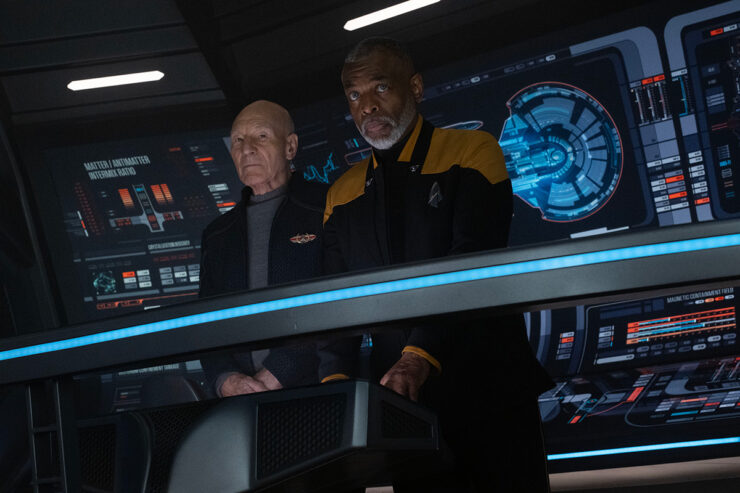One of the struggles in screenwriting is sometimes referred to as the Act 3 problem: Act 1 introduces everything, Act 2 gets the plot moving, and Act 4 is the climax and conclusion. But when you’re working in a proscribed format—like a one-hour TV show or a ten-episode season that tells a single story—sometimes you’re stuck spinning your wheels in Act 3. For a serialized ten-episode season of a TV show, that third act usually comes around the sixth or seventh episode.
Behold, the episode called “Dominion,” episode seven of Picard’s serialized third season, in which we actually learn quite a bit, but in which annoyingly little actually happens.
Mind you, the episode starts out brilliantly. The opening scene with Seven talking to Tim Russ’ Captain Tuvok, was at least as happy-making a joyous surprise as seeing Michelle Forbes’ Commander Ro walking down Titan’s corridor. Russ is fantastic, sliding right into Tuvok’s voice and mannerisms like it’s 2001 again. Titan is trying to find someone they can trust who can help them expose the changeling conspiracy. Seven tries all manner of rhetorical tricks to expose the changeling. She mentions their kal-toh games, with Tuvok pointing out that she often beat his ass in that logic game. (The game was introduced in Voyager’s “Alter Ego,” and Seven was seen defeating Tuvok, sort of, in “The Omega Directive.” The mention of kal-toh also prompts a music cue of Voyager’s theme song.) But eventually, she catches him out on not remembering a mind-meld Tuvok did with her to stabilize her neural pathways (possibly a reference to the events of “Infinite Regress”).
Russ is great here, because as soon as the changeling is caught out in the lie, his entire face relaxes, and he goes from being a calm Vulcan to a smug changeling. It’s a bravura performance, a welcome return of a great character and a superb actor, and I’m sorry we only get him briefly.
After cutting off the communication with “Tuvok” before the changelings can trace their call, La Forge says, “We can’t keep doing this,” indicating that Tuvok is not the first ally they’ve spoken to who’s turned out to be a changeling. (Tellingly, they haven’t yet been able to reach Admiral Janeway. This after Ro said in “Imposters” that she hadn’t been able to get through to Janeway, either. I really think they’re setting up a Kate Mulgrew appearance in one of the final three episodes…)
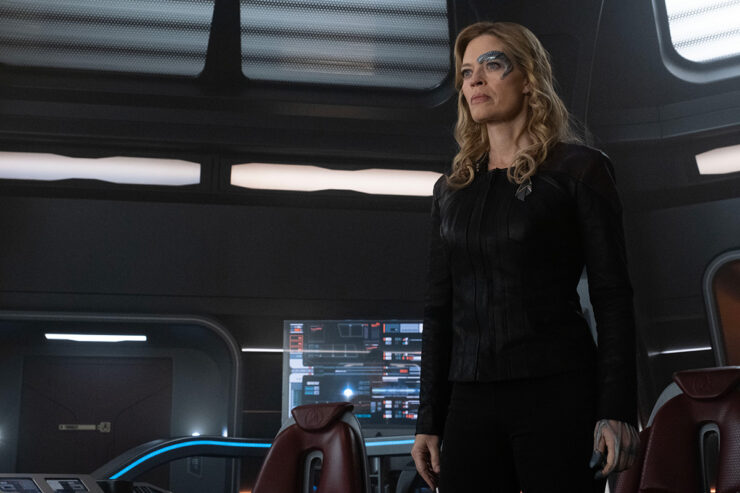
Titan is hiding in the Chin’toka Scrapyard—a DS9 reference that relates to the changelings, as Chin’toka was a star system in Cardassian space that changed hands several times during the Dominion War. They’re running out of time before Frontier Day, which is the changelings’ endgame, possibly using Picard’s body to create a perfect impersonation of him giving his speech at Frontier Day. Worf and Musiker have gone off in La Sirena, ostensibly to verify that Riker has not been captured by Starfleet Security, but in reality to not have to pay Michael Dorn and Michelle Hurd for this episode. (While it’s not as bad as season two, which was a budget-saving exercise in search of a plot, the lack of extra money to spend on this season is really obvious in so many cases, though at least we’re spared a Gratuitous Ten-Forward Scene this week…) Jack is fed up with being a plot device and offers to exchange himself for Riker to the changelings. Ed Speleers is particularly impressive as Jack in this scene. I’m still not sold on the character, but Speleers is doing a superb job of playing him.
Picard won’t allow Jack to commit the self-sacrifice, but it does give the admiral an idea.
The next thing that happens is one of my favorite bits on a Trek show because it’s a clever use of misdirection and of starships’ ability to drop force fields. Titan lures Vadic to Chin’toka with a distress call from a Vulcan ship (probably a derelict in the junkyard with T’Veen providing the distress call). Vadic boards Titan with a bunch of her thugs, and they’re all led on a merry chase by Jack and Sidney, then trapped by force fields set up by Seven and La Forge. It’s a beautifully executed plan.
However, this does lead us to the rather tired trope of the bad guy in prison and providing plot-convenient exposition. It’s one that particularly infused the popular consciousness in 1991’s The Silence of the Lambs, with Agent Starling’s questioning of the imprisoned Hannibal Lecter, then really metastasized in 2012 with various heroes talking to the imprisoned Loki in Avengers. (Trek previously made use of the trope with Khan in Star Trek Into Darkness.) Here we get Vadic trapped in a force field and completely unconcerned as she’s being interrogated by Picard and Crusher, though, in the tradition of Sir Anthony Hopkins, Tom Hiddleston, and Benedict Cumberbatch, Amanda Plummer puts in her best performance as Vadic to date when she’s being questioned by the admiral and the doctor.
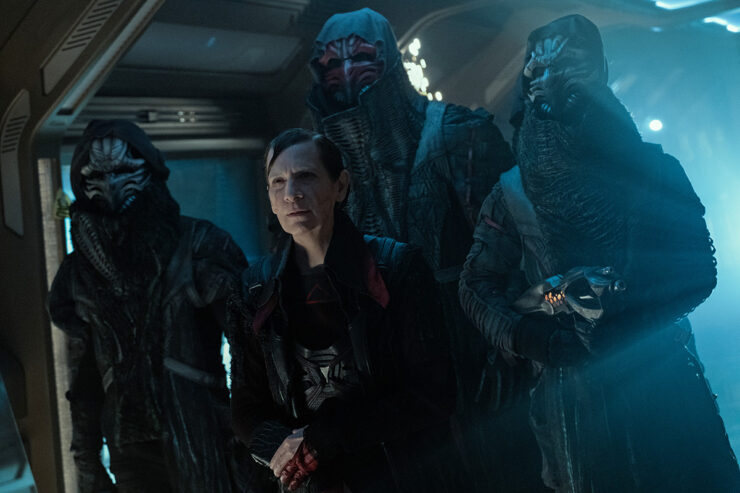
Vadic provides important information, though it’s not information I’m particularly thrilled to get. It was enough that there was a faction of changelings who were pissed about Section 31’s virus (which is constantly and mistakenly referred to as a Starfleet virus in this episode, though Vadic does rightly refute Picard’s claim that the Federation gave the Great Link the cure, when it was Odo who did that). But no, we’ve got to add to it and have these changelings be prisoners of war somehow taken by the allies during the Dominion War and brought to Daystrom Station where they were experimented on, and tortured, by a human scientist. But they eventually escaped, with Vadic taking on the same human form as the scientist who tortured her and her people.
I utterly despise this development, as it not only isn’t necessary, it’s yet another example of the Federation being shown, not to be the near-utopia that Gene Roddenberry envisioned, but a façade that hides the worst of humanity, which is the exact opposite of what Star Trek is supposed to be. The worst of humanity should be the isolated incidents, the bad apples, the exceptions.
I could even perhaps accept it as being an off-the-books Section 31 project—like all 31 projects, truthfully—but then we have Crusher and Picard, two of the most moral humans we’ve seen in the franchise, coming to the admittedly difficult decision that they have to execute Vadic. I find it especially hard to credit that the Jean-Luc Picard who was himself tortured at the hands of Gul Madred (TNG’s “Chain of Command, Part II”) would willingly kill a prisoner in his custody who had gone through something very similar.
One good thing that comes out of it is that Vadic provides the name of the operation—Project: Proteus—and Crusher and Picard are able to look it up in the Daystrom manifest. That, in turn, tells them of an isotope that is now in these super-duper changelings’ body chemistry (goo chemistry?), which will enable them to track the changelings.
Earlier in the episode, Crusher mentioned a potential moral dilemma: finding a way to track the changelings biologically is the sort of thing that can lead to genocide. And now they have that method—which, conveniently, is something that only these rebels-with-a-cause changelings have, and which is likely to be made use of for more than tracking.
To make matters worse, our heroes’ brilliant and successful plan to trap Vadic and her people is ruined by Lore.
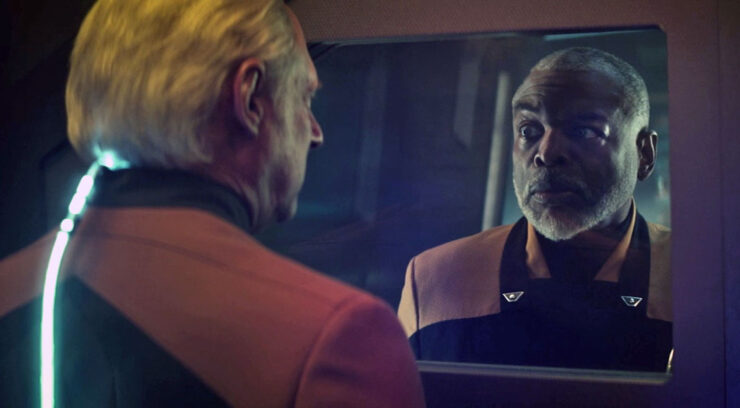
Last week, we were both told and shown that the artificial lifeform that Altan Soong created was an amalgam of Data, Lore, B-4, Soong himself, and Lal. This week, for some reason, it’s not quite that. According to La Forge, B-4 and Soong are just memory files, there’s no mention at all of Lal, and both Lore’s and Data’s full personalities are in the positronic matrix, and they’re fighting for control the body that we’re just gonna call BS for the time being (for Brent Spiner, of course). Despite the fact that the majority of what’s in BS’s mind is Data, according to Soong (in a scene from “The Bounty” that we’re shown again in the “previously on” segment), Lore manages to wrest control of BS just as Picard and Crusher make their horrible decision—oh and when Sidney and Jack are trapped in a corridor by a force field that’s all that’s keeping several of Vadic’s thugs from killing them. Lore is of course able to take over the ship’s systems, er, somehow, and keep them just long enough for Vadic to escape and take over the bridge. Data doesn’t wrest control back—after a lot of emotional pleading by La Forge, which is, I gotta say, very well delivered by LeVar Burton, who’s doing some of his best work—until it’s too late. (It helps that the resistance to Vadic’s bridge takeover, led by Seven, is pretty inept. After an episode that had up until that point had excellent fight choreography—indeed, a season that has had such—it’s disappointing to watch the bridge crew stand around with their thumbs up their asses while the changelings take over.)
It’s the cheapest of writer’s tricks—and actor’s tricks, truly, as Spiner gets to flip back and forth between Data and Lore, which is obviously a lot of fun for him—by having our heroes’ work undermined by a plot contrivance. And it is such a contrivance, put there to delay the climax, because we’re only in episode seven and there are three more episodes to go. Gotta keep Act 3 going!
On top of that, while we do get the revelation as to why this batch of changelings are so pissed, we still have a lot of unanswered questions. BS informs us that the body of Picard that was taken has some anomalies, which put the Irumodic Syndrome diagnosis in question. And if it’s in question for Picard, it might also be so for his son.
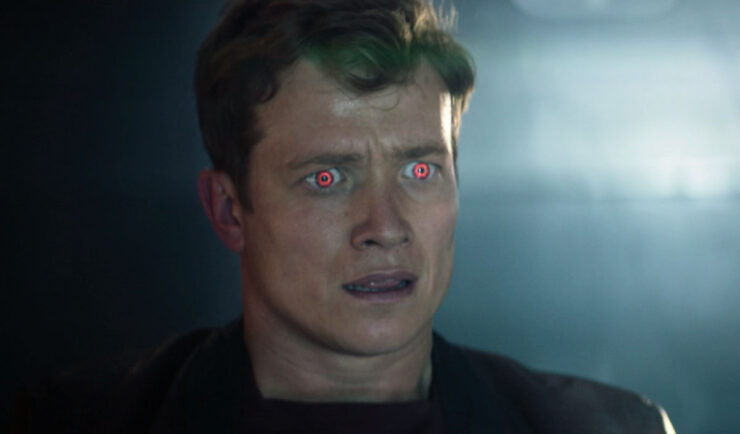
Adding fuel to that particular fire is Jack’s suddenly developing telepathic skills. He hears Sidney’s thoughts—and uses that psionic eavesdropping to help himself flirt with her—and later, after the force fields have gone down, he psychically manipulates her. Somehow, Jack links their minds so that every move he makes, she makes, which makes her a much better fighter, able to take Vadic’s thugs down.
The episode ends, maddeningly, with Vadic telling Jack it’s about time he finds out who he really is. And earlier, Vadic came out and told Crusher that she doesn’t know what he really is, either, which is a neat trick for the guy’s mother who’s been on the run with him all his life…
Buy the Book
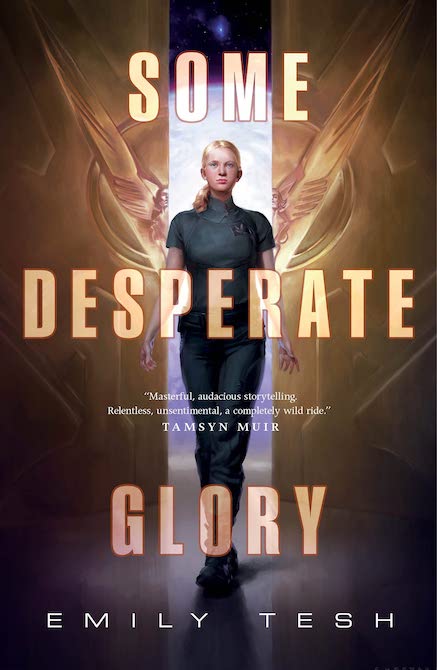

Some Desperate Glory
There are good aspects to this episode beyond Tim Russ’ appearance. Shaw remains delightful, though his continued insistence on referring to Seven as “Hansen” (in the same scene in which someone whom he thinks is another captain, and one with several decades’ more experience in Starfleet than he, refers to her as “Seven”) rankles. I particularly like when the force field plan works and he stares at the monitor and says, “Holy shit, we got her.”
And in general this season is doing something that I always wanted the shows to do more of (and which the tie-in fiction has done routinely): treat this like one big universe. Throughout the first wave of spinoffs, it felt like there was a gauze curtain between the shows, only occasionally peeking through with a guest star here or a plot point there. TNG was TNG, DS9 was DS9, Voyager was Voyager, and Enterprise was Enterprise. The latter two were separated from the others by space and time, respectively, at least, so it made more sense. But it was just annoying that there weren’t more casual references to other parts of the universe, like a Sovereign-class ship or two among the fleets of the Dominion War, or more overt references to Worf’s life on Deep Space 9 in the TNG movies, or more than just oblique references to the events of DS9 on Voyager after “Pathfinder.”
The Secret Hideout shows in general have been better about this, and this season of Picard has particularly been good about embracing the entirety of the Trek universe, in particular all the twenty-fourth century shows. Besides being a TNG reunion, there are heavy elements of Voyager in the opening scene, and the events of DS9’s sixth and seventh seasons greatly inform Vadic’s info-dump. This episode especially feels like it inhabits the Trek universe, not just the TNG/Picard piece of it.
I just wish more happened in it, and that what did happen didn’t really really annoy me…
Keith R.A. DeCandido has written the character of Tuvok in the novels The Brave and the Bold Book 2 and Q & A, and also wrote the Mirror Universe version of Tuvok in the short novel The Mirror-Scaled Serpent in Mirror Universe: Obsidian Alliances.










